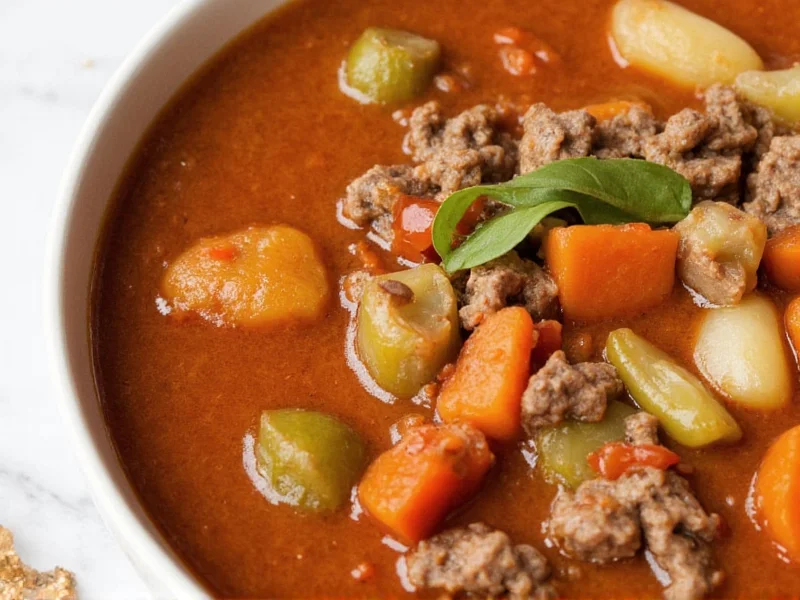Nothing beats a steaming bowl of homemade vegetable beef soup on a chilly day. This classic comfort food combines protein-rich beef with nutrient-dense vegetables in a savory broth that satisfies both hunger and soul. The magic happens through proper technique: searing the meat to develop fond, layering vegetables at optimal times, and allowing sufficient simmering for flavors to meld.
Essential Ingredients Explained
Understanding why each ingredient matters helps you create superior soup. Quality components transform this humble dish from ordinary to extraordinary.
| Ingredient | Why It Matters | Substitution Options |
|---|---|---|
| Stew beef (chuck or round) | Marbling provides flavor and becomes tender during slow cooking | Oxtail, short ribs, or leaner cuts with longer cooking time |
| Beef broth (low sodium) | Forms flavor foundation without overwhelming saltiness | Homemade stock or mushroom broth for vegetarian version |
| Diced tomatoes with juice | Adds acidity that balances richness and enhances other flavors | Tomato paste (2 tbsp) + water if fresh tomatoes unavailable |
| Fresh mirepoix (carrots, celery, onion) | Creates aromatic base essential for depth of flavor | Parsnips or leeks can complement traditional mirepoix |
Step-by-Step Preparation Guide
Follow these professional techniques to achieve restaurant-quality results in your kitchen. Proper timing ensures vegetables maintain ideal texture while flavors fully develop.
Meat Preparation (20 minutes)
- Pat 1.5 lbs stew beef cubes completely dry with paper towels
- Season generously with black pepper and 1 tsp smoked paprika
- Heat 2 tbsp olive oil in heavy-bottomed pot over medium-high heat
- Sear meat in single layer without crowding (work in batches)
- Remove browned meat and set aside, leaving flavorful fond in pot
Soup Assembly (10 minutes + 1.5 hours simmering)
- Sauté 1 diced onion, 2 chopped carrots, and 2 celery stalks for 5-7 minutes
- Add 2 minced garlic cloves and cook 1 minute until fragrant
- Stir in 2 tbsp tomato paste and cook 2 minutes to deepen flavor
- Return meat to pot with accumulated juices
- Pour in 4 cups beef broth, 2 cups diced tomatoes, 1 bay leaf, and 1 tsp thyme
- Bring to gentle boil, then reduce heat to low and cover
- Simmer 60 minutes until meat begins to tenderize
- Add 1 cup diced potatoes and 1 cup green beans, simmer 30 more minutes
- Stir in 1 cup frozen peas during last 5 minutes of cooking
- Remove bay leaf, adjust seasoning with salt and pepper to taste
Proven Variations for Different Needs
Adapt this versatile recipe to suit dietary requirements or time constraints without sacrificing flavor. These tested modifications maintain the soup's essential character while addressing specific needs.
Time-Saving Vegetable Beef Soup
When you need soup faster, use these techniques that preserve flavor despite shorter cooking:
- Use pre-cut stew beef (look for "soup meat" at butcher)
- Substitute 1 cup red wine for equal parts broth to accelerate flavor development
- Add hearty vegetables (potatoes, carrots) frozen rather than fresh
- Maintain minimum 45-minute simmer for proper flavor integration
- Finish with fresh parsley and a splash of Worcestershire sauce
Health-Conscious Adaptation
Create a lighter version that doesn't compromise on satisfaction:
- Choose leaner beef cuts like top round and trim all visible fat
- Use 3 cups low-sodium broth plus 1 cup water to control sodium
- Increase vegetable ratio to 50% of total volume
- Add 1 tbsp apple cider vinegar at the end to brighten flavors
- Include fiber-rich additions like diced turnips or parsnips
Critical Success Factors
Avoid common pitfalls that turn promising soup into disappointment. These professional insights make the difference between good and exceptional results.
Temperature Control Matters
Many home cooks make the mistake of boiling soup vigorously throughout cooking. Instead, maintain a gentle simmer after initial boiling - bubbles should barely break the surface. Rapid boiling shreds meat fibers and clouds broth. For clear, flavorful results, keep temperature between 185-205°F (85-96°C) during simmering phase.
Layering Vegetables Strategically
Dense vegetables like potatoes and carrots need more cooking time than delicate ones. Add root vegetables with the meat, but introduce softer vegetables (zucchini, peas, spinach) during the final 10-15 minutes. This prevents mushiness while ensuring thorough cooking. For best results, cut vegetables uniformly to 1/2-inch pieces for even cooking.
Storage and Reheating Best Practices
Proper handling maintains quality when enjoying leftovers. Vegetable beef soup actually improves overnight as flavors continue melding.
- Cool soup within 2 hours of cooking to prevent bacterial growth
- Store in airtight containers with 1/2 inch headspace for expansion
- Refrigerate for up to 4 days or freeze for 3 months
- When reheating, add small amounts of broth if soup has thickened
- Never microwave frozen soup - thaw in refrigerator first
Perfect Pairings and Serving Suggestions
Elevate your vegetable beef soup experience with these complementary elements that enhance both flavor and nutrition.
Serve in pre-warmed bowls to maintain ideal eating temperature longer. A sprinkle of freshly grated Parmesan adds umami depth, while a dash of hot sauce provides contrast to the rich broth. For complete meal satisfaction, pair with:
- Crusty whole-grain bread for dipping
- Simple green salad with vinaigrette dressing
- Roasted Brussels sprouts for complementary earthiness
- Apple slices for refreshing palate contrast
Troubleshooting Common Issues
Resolve these frequent vegetable beef soup problems with professional solutions.
Soup Too Thin or Lacking Body
If your broth seems watery, create a quick slurry: mix 1 tbsp cornstarch with 2 tbsp cold water, then whisk into simmering soup. Alternatively, remove 1 cup of soup (mostly vegetables), puree until smooth, and return to pot. This thickens without altering flavor profile.
Meat Tough or Dry
Overcooked beef becomes tough rather than tender. If this happens, remove meat pieces, shred with forks, and return to soup. The smaller pieces will continue softening during storage. For future batches, ensure beef simmers gently rather than boiling, and consider slightly reducing cooking time.











 浙公网安备
33010002000092号
浙公网安备
33010002000092号 浙B2-20120091-4
浙B2-20120091-4